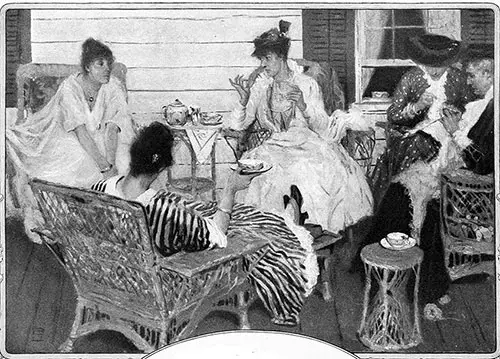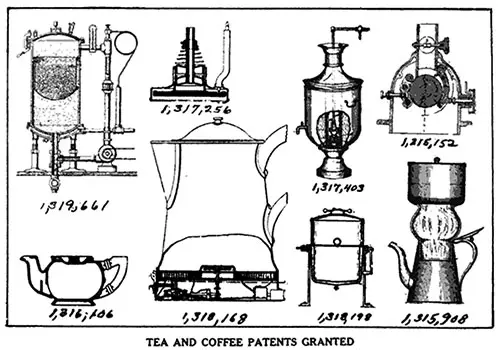Ways for Housewife to Make Coffee - 1922

Information for the Housewife That Has Only an Old-Fashioned Pot.
Special Correspondence
Kansas City, July 10, 1922.
E Ennis-Hanly-Blackburn Coffee Co., coffee and tea wholesaler of this city, prepared the following on the preparation of coffee by the ordinary means in the average household, which was broadcasted from the W-D-A-F wireless station of the Kansas City Star on July 7th:
Large display advertisements on the subject of coffee, signed by the Joint Coffee Trade Publicity Committee, have been running for several years in the leading newspapers and magazines. This committee is composed of selected members from the green-coffee importers and the coffee roasters of the United States.
These two divisions of the coffee trade, the importers and the roasters, have allied themselves with the coffee planters of Brazil, the chief coffee producing country of the world, for the main purpose of ascertaining the real facts as to the dietetic value and physiological characteristics of coffee as a beverage, and of giving full publicity to these facts when and as determined.
To the end that the facts developed be accept able as conclusive and authentic, it was recognized as imperative that the researches be conducted by an institution of unquestioned scientific standing, and the committee therefore commissioned the Massachusetts Institute of Technology to undertake the work, which is now in the second year and costs the committee $12,000 a year.
The vast amount of experimenting required has been conducted under the able direction of S. C. Prescott, professor of industrial biology at the institute mentioned, and his report covering the operations of the preceding 12 months was presented by him at the annual convention of the National Coffee Roasters Association, Nov. 2, 1921, New York City.
Prof. Prescott jumps at no conclusions in his report. Every statement made by him is backed by a detailed account of the multitude of careful and varied experiments, repeated and checked and cross-checked, required to convince the trained scientific investigator that he had exhausted every known channel of information on the matter in hand and every available means of digging out the exact facts beyond dispute.
The Housewife's Problems

Prof. Prescott's published findings are clarified and condensed for the purposes of this address, to answer briefly and practically two ever-present problems that confront the intelligent housewife.
1. What is the best way to make coffee in a plain coffee pot?
2. What is the very best way of all to make coffee in the home kitchen?
These are vital questions unanswered so far, at least not satisfactorily answered; as, speaking generally, no two home cooks agree in their ideas, no two cookbooks agree in their recipes, and no two coffee roasters agree in the directions on their packages.
Note carefully that the leading factors studied in the course of the extended and comprehensive researches referred to were the following:
- The character of the water.
- Temperature of brewing.
- Time of treatment.
- Method of preparation.
- Character of material of the pot used.
The Prescott report demonstrates that the actual quality of coffee, the genuine flavor and full strength of any coffee, whatever the variety or the blend, or the name of the brand, or the price, is completely spoiled when the mixture of water and coffee is brought to the boiling point (212° Fahrenheit). If you boil your coffee five minutes or one minute or a fraction of a second, you destroy the main part of its flavor, and you produce in it new and undesirable chemical compounds, substances not present until the temperature passes above 200° Fahrenheit, and that pot is 12° below boiling.
Take the coffee you now boil to death and make it with the care it deserves according to the few simple rules we give you presently make it this way a sufficient number of times to test the method honestly and fairly, and then, if you go back to boiled coffee, be assured that your sense of taste as to coffee has been seriously impaired.
The Kind of Coffee Pot
The best plain pot to use is one with a glazed inner surface, and it may be vitrified or other glazed china or earthenware, or the metal pot, known as agateware, or graniteware, with an inner surface like porcelain.
Any unglazed metal surface—aluminum, copper, tin, tinplate, nickel, or silver—gives a metallic taste to coffee; aluminum perhaps least of any metal; while tin imparts the most pronounced metallic taste. At best there is a marked difference in taste in favor of the graniteware pot, as against any metal surface; but, if you cannot get a good graniteware pot, use one of aluminum, if it is available. Otherwise, use what you have, but keep it always thoroughly clean.
And don't use the grounds but once, any more than you would cook with rancid lard or stale eggs.
The finer the coffee is ground, short of pulverizing, the better. Have it ground as nearly as possible to the fineness of granulated sugar. At tach great importance to this point.
The use of eggshell for settling coffee made in a plain pot is effective and satisfactory, and no objection to it has developed. The use of the white or the yellow of an egg is not required unless to enrich the brew ; a point not yet determined.
The traditional tablespoonful of coffee for each cup and one for the pot were good enough for the strong, rank coffees of 50 years ago, but are inaccurate and misleading for the mild, high-flavored South American and Central American coffees of the present day.
The amount of ground coffee necessary to make a certain number of cups of the strength desired by the individual family can be arrived at only by trial, and when once determined do not vary it. Next to boiling coffee, the weakest point in home coffee making is the use of too little coffee for the quantity of water. Figure generally on the larger basis of 2% gallons of water to a pound of coffee; in other words, 40 cups to the pound, two ounces to five cups, four ounces to 10 cups, and so on.
A prize offered some years ago for the best coffee recipe was awarded to a hotel chef. His recipe contained only these three words:
Use enough coffee.'
How to Use a Plain Pot
We shall take his recipe and add to it a brief summary of the foregoing argument as a complete and sufficient answer to the first query, ‘What is the best way to make coffee in a plain pot?'
- Use enough coffee.
- Use glazed earthenware or graniteware or aluminum pot, if possible.
- Put, dry coffee into the clean, empty pot.
- Add a little clean eggshell for settling.
- Bring water to boiling in separate vessel.
- Reduce heat until water stops tumbling.
- Measure water by cups into the pot.
- Stir thoroughly.
- If eggshell is not used, pour tablespoonful of cold water into the spout.
- Set pot on heat where it will not even simmer.
- Serve within 10 to 40 minutes.
- For good coffee's sake, use care in each operation!
The Best Way of All
Query No. 2–'What is the very best way of all to make, coffee in the home kitchen?'—may be answered briefly but fully by stating that no better way is known, so far as concerns flavor, aroma, and strength, of the beverage produced, than in a plain pot. The drawbacks to the plain pot are the care required in the process and the difficulty of pouring all the coffee off the grounds.
.The flter or drip-pot process is equally efficient, and has the advantage of being more easily operated.
The best filter pot would have both the bottom of pot and the upped part, carrying the bag or filter paper, made of glazed earthenware or graniteware.
The next best would be a glazed pot with aluminum upper part, and the next best would have both parts aluminum, for reasons already given.
Follow directions for using the plain pot, except as to eggshell, and of course there are no stir ring to be done and no cold water in the spout.
If a cloth bag is used as a filter, do not allow the bag to get dry. Cleanse it thoroughly after each making and keep it in cold water until the next time. This prevents all danger of the bag getting sour.
The Prescott report states that the percolation process, in which hot water is kept constantly passing over the ground coffee, yields much less desirable results and is in fact far from satisfactory. Hence, the drip pot is decidedly better than the percolator.
Some Important Don'ts.
Even though you may not closely follow these directions for making the very best coffee possible in your home, remember these extremely important don'ts:
- Don’t use too little coffee.
- Don't allow boiling water to touch the coffee.
- Don’t allow coffee to get hot enough to simmer after it is made.
- Don’t make coffee over 45 minutes before serving
- Don't use the grounds but once.
- Don’t, don’t, don't get careless!
And now we quote the final paragraphs of the address of Edward Aborn, chairman Better Coffee Making Committee, which was broadcasted June 17 from Westinghouse station W-J-Z, New ark, N. J.:
Though always a joy to us, we are only beginning to understand the true human value of rightly brewed coffee, the Drink of Gladness.”
Following Solomon's ancient wisdom, scientists tell us that gladness has nutritive value and that taste sensations start digestive juices. Like no other product, coffee aroma thrills our senses and brightens our moods. It brings us the graces of pleasure, anticipation, realization, and reflection.
The Massachusetts Institute of Technology, summarizing all recorded scientific reports, states that the stimulating element in coffee, caffeine, has been proved an uplifting stimulant, with no after depression. Used in moderation, coffee is a great human resource. It deserves your intelligent interest, your understanding of modern information about better brewing, which will multiply coffee satisfaction and comfort in every home. Give it your intelligent care.”
Homely Ways to Make Coffee,” in The Tea and Coffee Trade Journal, New York: The Tea and Coffee Trade Journal Co., Vol. 42, No. 8, August 1922, p. 211-212.
